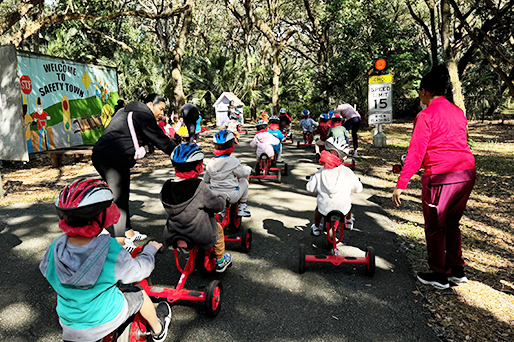Injury Prevention

Trauma is the leading cause of death for people 45 years and younger in the U.S. Every year, 150,000+ deaths and over 3 million non-fatal injuries occur. Most if not all of these injuries are preventable, and many lives can be saved, by following practical and well-established injury prevention strategies.
For more information and questions about trauma education, please email traumaeducation@mhs.net.Adult Injury Prevention

In the United States, preventable injuries in adults are at an all-time high, ranking as the third leading cause of death behind heart disease and cancer.
Below are tips and resources to learn how to prevent injuries in adults.
Fall Prevention Resources
Falls are the leading cause of injury-related death, hospitalization, and emergency visits for people over 65; and every second, an older adult falls. Fortunately, most falls are preventable. It’s important to understand your fall risk to stop falls before they happen.
Take these steps to prevent falls:
- Understand your fall risks and reduce as many risk factors as possible.
- “Fall proof” your home by using the How to Prevent Falls: A Home Safety Checklist.
- Work with your health care providers to advocate for yourself and your health.
- Stay socially connected, active, and strong to maintain independence.
Click on the following links for additional resources in English and Spanish:
Motor Vehicle Safety Resources
Motor vehicle crashes are a leading cause of death and injury. It's the second most common unintentional injury among adults and the most common reason teens aged 15-19 are admitted to the trauma center. The good news is that most motor vehicle crashes are preventable if you follow these proven strategies:
- Buckle up and make sure everyone in the vehicle is wearing their seatbelt before driving
- Avoid distractions like your cell phone
- Drive the speed limit
- Maintain a safe travel distance
- Always choose a sober driver
Download the iPhone Do Not Disturb While Driving instructions.
Motorcycle Safety Resources
Florida has the highest number of motorcycle deaths in the nation. Florida requires motorcycle riders to wear protective headgear because helmets save lives and prevent the risk of head injury by nearly 70%. Follow these tips to stay safe while riding your motorcycle:
- Wear a Department of Transportation-approved helmet.
- Wear bright and reflective clothing.
- Maintain a high level of awareness.
- Slow down, leave space between you and the vehicle in front of you, and obey all traffic laws.
- Ride smart and let motorists know your intentions by using signals.
Download the Gear Up for Safety infographic.
Firearm Safety Resources
Firearm injuries are the leading cause of death in children and teens. Approximately 4 in 10 households (42%) have at least one firearm. Download the flyer below and follow these steps to keep your family safe from firearms:
- Store firearms unloaded
- Lock firearms
- Keep firearms safely out of reach
Download the Firearm Safety flyer.
General Injury Prevention Resources
Childhood Injury Prevention

In the United States, preventable injuries are the leading cause of death in children and young adults. According to the CDC, approximately 12,000 children and young adults, ages 1 to 19 years, die from unintentional injuries each year.
Below are tips and resources to learn how to prevent injuries in children.
Bicycle Safety Resources
Florida is the third most dangerous state in the country for cyclists. Children are at a particularly high risk for bicycle-related injuries. You can help keep your family safe while riding bicycles by:
- Ensuring everyone wears a properly fit helmet and bright colors
- Doing an “ABC” check before riding
- Following the rules of the road
- Riding predictably
Click on the following link for additional resources:
Car Seat Safety Resources
Approximately half of all car seats are installed incorrectly. Improper car seat installation can reduce the protective abilities of the seat during a crash. You can keep your family safe by:
- Getting your car seat checked by a certified child passenger safety technician (visit Safe Kids Broward or Florida Child Seat Safety for a list of inspection locations near you).
- Regularly check your car seat to ensure it is installed correctly and fits your child as they grow.
Click on the following links for additional resources:
Fall Prevention Resources
Falls are the most common type of injury we see in children. We know some of these falls are unavoidable while children learn through play. Serious falls can be prevented by:- Strapping furniture to the wall to avoid furniture tipping over
- Blocking stairways and window ledges
- Teaching children to use playground equipment currently
- Never place a baby seat or carrier on an elevated surface
- Ensure children are always strapped into car seats, high chairs, and shopping carts
Click on the following link for additional resources:
On average, 38 children die in hot cars each year. A child’s body heats up 5x faster than an adult's, making them more vulnerable – which is why every second matters.
ACT to prevent heatstroke by following these tips to prevent your child from being left in a hot car:
- Avoid heatstroke-related injury: Always check the back seat before you leave the vehicle. Lock your vehicle and never let your children play in or near them so they can't let themselves in.
- Create reminders: Put your purse, briefcase, lunch, etc. in the backseat so you are sure to look before you lock the door.
- Take action: If you see a child alone in a car, call 911.
- Ask your childcare provider to call if your child doesn’t show up for care as expected.
- Rolling windows down or parking in the shade does little to change the interior temperature of the vehicle.
- If there is a change in plans and someone else is dropping your kid(s) off, have them call you at drop-off so you know everyone made it safely.
Motor Vehicle Safety Resources
Motor vehicle injuries are a leading cause of death among children and the most common reason teens aged 15-19 are admitted to the trauma center. However, many of these deaths can be prevented. To reduce the risk of serious injury and death, follow these tips:
- Properly buckle children in car seats, booster seats, or seat belts appropriate for their age and size.
- Regularly check your child's car seat to make sure it is installed correctly and fits your child as they grow (visit Safe Kids Broward for a list of inspection locations near you).
- Don't seat children in front of an airbag.
- Buckle children in the middle of the back seat when possible.
- Ensure that children are properly buckled in the back seat until age 13.
- Always choose a sober driver to transport your kids.
- Parents and caregivers can set a good example by always wearing a seat belt.
Click on the following links for additional resources:
Pedestrian injuries and fatalities remain high in Florida, with South Florida ranking as the 14th most dangerous metro area for pedestrians nationwide. Protect your family while walking by:
- Teaching children to stop at the curb or edge of the road and look left, right, and left again before crossing. Walk, do not run, or dart into the road.
- Always walk on the sidewalk if there is one. If there is no sidewalk, walk facing traffic.
- Always cross at a crosswalk and follow pedestrian signals to cross. Make eye contact with the driver before crossing – even if the sign says it is safe to walk.
- Avoid distractions and wear bright-colored clothing to make it easier for drivers to see you.
Poison Prevention Resources
Poisoning is now a leading cause of injury death in Florida, and children under 5 years of age are the group most likely to have accidental poisoning, which can impact a child’s normal growth and development. The most common exposures include:
- Household cleaning products
- Pain medication
- Cosmetics
- Personal care products
America's Poison Centers is open 24/7 and represents 54 accredited poison control centers in the U.S. Follow these steps to help keep your family safe:
- Save their phone number (1-800-222-1222) and call for all exposure questions
- Store chemicals up and away so children and pets can't access them
- Store chemicals and cleaning products in their original containers
Click on the following links for additional resources:
Safe Infant Sleep Resources
Did you know that children under the age of one represent nearly 100% of unsafe sleep fatalities in Florida, making it a leading cause of preventable infant death in our state?
Sudden unexpected infant death (SUID) is the leading cause of injury death in infancy. Practicing safe sleep guidelines can prevent most SUID deaths in infants. Follow the ABCDs to keep your family safe:
- Alone: Babies should sleep alone in their own sleep space.
- Back: Babies should be placed on their backs to sleep.
- Crib: Babies should sleep in an empty sleep space that has a firm, flat mattress, and tight-fitting sheet.
- Develop: Develop a Safe Sleep Plan that describes where your baby will sleep, coping strategies to use when baby is fussy and who you can call for added support when you need help.
Click on the following links for additional resources:
Water Safety Resources
Drowning is the leading cause of unintentional death for children 1 to 4 years of age. It can happen in as little as two inches of water, within seconds, and is often silent. Keep your family safe near water by:
- Teaching children to swim
- Installing pool fences and door alarms
- Assigning a "water watcher"
- Wearing a life jacket
- Learning CPR
Click on the following links for additional resources:
- Drowning Prevention (poster or rack card)
- Pool Safety Checklist
General Injury Prevention Resources
Donate to Safe Kids Broward
DonateSchedule Safety Town Field Trip
Safety Town











